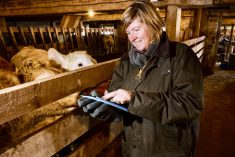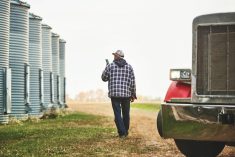“Every other business in this country has access to outside investors and outside capital; why shouldn’t farmers have that too?” asks the CEO of Canada’s largest provider of land-lease financing for farmers.
“Farmers should have all the same financial tools that a tech company or a mining company does,” Tom Eisenhauer tells us. “That’s what we provide. We’re helping farmers stay on the farm. We’re helping farmers be more profitable, and we’re helping them reduce their financial risks.”
The financial foundation for such a business is widely acknowledged. Farmland is pricey, and getting pricier every year. And farming has always been a capital intensive business, so if the expense-to-revenue ratio averaged 82.9 cents per dollar — significantly better than the long-term average — it’s still a tough business to build a career on.
Read Also

Farmland values: assumptions and realities
Where farmland values are headed and what decisions farmers should make
Then, add on that farmers who want to expand, farm at scale, or reduce their debt often lack access to long-term capital, so investors believe there’s a gap that they can help to bridge.

Companies like Bonnefield, Area One Farms and AGInvest create long-term partnerships with farmers. Yes, they take different approaches to structuring deals but they explain their businesses the same way: their goal is to offer an alternative method of financial support.
Do farmers agree? That — plus more — is what we wanted to ask Eisenhauer. His answers, lightly edited for brevity, are below.
Country Guide: Tell us how Bonnefield got started.
Tom Eisenhauer: When we first started the business (in 2009), we were trying to solve a financial problem for farmers.
So many farms face a similar problem: They have a great business, great operations, their crop is in great demand but it’s such a capital intensive business and farming 5,000 acres means financing land, financing equipment and it can be $10 million or $20 million, so they have cash-flow issues or balance sheet issues.
Farmers, unlike most other businesses, have a limited set of options. Banks offer mortgage debt, equipment manufacturers provide financing for equipment and seed, and the input suppliers will sometimes provide financing… but it still leaves a huge part of the operation that needs to be financed — and that’s where we come in.
We were able to convince investors to invest with Bonnefield and we use those investments to purchase farmland and offer lease-back financing to farmers.
CG: Is there a “typical” scenario that leads a farmer to work with Bonnefield?
TE: There are a few different scenarios that we see most often.
Farmers have amassed land and amassed debt and the bank is knocking on their door, Bonnefield comes in and purchases a portion of the farm, but never the whole farm, and the farmer uses the cash to reduce their debt and we lease it back to them on a long-term basis to continue farming. They are still farming the same land but now have the capital to fix their balance sheet and get out of debt.
Younger farmers who have been farming a few hundred acres want to scale but purchasing the land would destroy their balance sheet. Often, they’ve identified land — maybe a neighbouring farmer is retiring and has offered to sell them land, but the bank won’t give them a loan — and we work with the landowner to purchase the land and lease it to the farmer. It gives the farmer the ability to farm at scale and better capacity utilization on their equipment, and it makes them way more profitable.
We also work with farmers going through the succession process. A farmer wants to retire, one child wants to take over the farm and the others have no interest, so that one person has to buy out their brothers and sisters and can’t afford it. Bonnefield will buy some of the acres — enough to allow the younger farmer who’s buying in to buy out their siblings — and lease it back to them.
CG: You mentioned that Bonnefield never purchases the entire farm, just a portion. Can you explain why?
TE: We want to have farm partners; we don’t want to operate as landlords and have tenant farmers. Buying only a portion of the farm ensures that farmers still have some skin in the game. To be honest, if a farmer came to us and wanted to sell the entire farm, our antenna would go up and we’d be thinking, “What’s wrong here?”
There was one exception. In 2013, a 6,500-acre parcel of land came available in Dufferin County, Ontario, that was owned by a hedge fund in Boston. We bought the land and went out to find local farmers to farm it for us. So we have six local farm families who are operating there now.
(Note: Eisenhauer told the Financial Post that the price was “more than $50 million” and it was recorded as one of the largest farmland transactions in Canadian history.)
CG: How do you determine the lease rate per acre?
TE: We’ve developed a sophisticated underwriting process that assesses how much yield can be produced on the land and the revenue that those crops will produce and the expected profit. From there, we consider what’s a fair share for the landlord to earn from that and it’s generally between 25 and 35 per cent.
If we price the lease rates so high that farmers can’t afford them and the farmer goes broke, we’re in a world of hurt. So, there is always negotiation but, in general, it doesn’t work for us unless the farmer is successful.
When we buy land, we often have money left that we can use to invest in irrigation systems or subsurface drainage or onsite storage, so we can add in those other investments and increase the rent slightly so the farmer can pay it off over time.
CG: How has the model changed since 2009?
TE: We’ve been around for a long time and quite a number of farmers have come to us and said, “We really like the farmland assistance you’ve been able to provide us but we need help with processing facilities or storage facilities or cold packing facilities. ”
Until recently, we had to say that it was outside of our mandate. In July 2023, we launched a new fund that we’re calling our Integrated Agriculture Fund to help finance infrastructure and we do that through a more traditional private equity approach where we take a non-controlling position in their facilities so our investment is paid back over time as their profits increase.
CG: How have the huge increases in farmland value and high interest rates affected the model?
TE: As farmland gets more expensive, so do the risks. We have to be very careful not to overpay for land and that means sitting down with farmers and making sure the price we pay is fair for them and fair for us.
Rising interest rates have increased the level of interest from farmers in what we’re doing. A few years ago, when interest rates were 3 per cent or so, their debt was manageable but in today’s interest-rate environment, farmers have to be cautious and de-risk their businesses and we can help them do that.
CG: Has Bonnefield targeted farmers as investors?
TE: We have a few farmers as investors because no one values or understands land better than farmers. The challenge for many farmers is that all of their capital is tied up in their land and their business operations, which means there is no capital to invest.
CG: What are some of your long-term goals for Bonnefield?
TE: We don’t have benchmarks or targets in terms of the amount of dollars or land or relationships, but our vision is to be the leading provider to farmers in Canada of an alternative to bank debt and to continue working with more farmers across the country to help them solve their needs in more interesting ways.
CG: What are some of the common criticisms of the model and how do you respond to them?
TE: There is a frequent misperception that investors like Bonnefield are driving up the price of land. In fact, the opposite is generally the case. We can’t go in and overpay for land and still make money for our investors. We have to be able to make a reasonable return for our investors by leasing it back to the farmers, so we have to be fairly price conscious.
There are also some people who have philosophical concerns and believe that the only people who should own farms in Canada are farmers. I’d like that too, but how are farmers going to afford it?
– This article was originally published in the February 27, 2024 issue of Country Guide.















